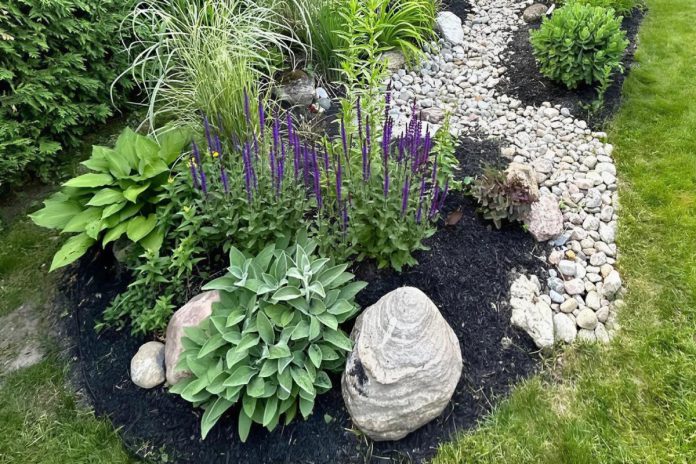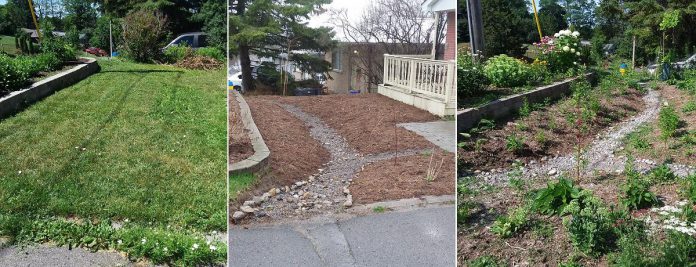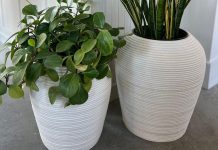
Peterborough is no stranger to heavy rain — whether it’s a 100-year flood, an April shower, or a good ol’ summer storm, the city’s stormwater systems are frequently put to the test.
Often the rain is a blessing for a garden but, once the ground is saturated, additional rain — especially too much, too fast — puts pressure on the city stormwater system. Big rain events can lead to localized flooding and erosion that transports polluted runoff into places like Jackson Creek and the Otonabee River.
Is there a way to ease the strain on city infrastructure while giving nature a boost? Across the city, a quiet green solution is taking root: rain gardens.
Rain gardens are a simple, beautiful, and increasingly popular way to make a property more environmentally friendly and storm resilient. At first glance, a rain garden may look like any other carefully tended patch of flowers and native plants, but these shallow bowl-shaped gardens are special.
By following the steps in the City of Peterborough’s Rain Garden Subsidy program, homeowners and contractors can design a rain garden that is specifically sized to capture and filter rainwater runoff from a nearby roof.
With a few simple calculations, a rain garden is easily designed to hold water for up to 24 hours after a heavy rain, so the water has time to soak slowly into the ground — this process naturally filters out pollutants and replenishes the water table.

This before, during, and after photo shows the transformation of a resource-intensive lawn into a functional stormwater filtering system. The garden will bloom into a visually pleasing, and hardworking greenspace. (Photos: GreenUP)
Compared to a conventional grass lawn, rain gardens can filter out up to 90 per cent of chemicals and 80 per cent of sediment, while allowing about 30 per cent more water to seep into the earth. That’s a big win for the creeks and rivers — and for aging stormwater systems.
But these gardens aren’t just good for the city’s pipes and waterways.
Rain gardens also act as mini habitats. When planted with native species, they provide food and shelter for pollinators like bees and butterflies and help support urban biodiversity in a very real way.
By using native plants like white turtlehead, swamp milkweed, Canada anemone, blue flag iris, and bee balm, homeowners are creating little sanctuaries that thrive in local conditions — all while adding vibrant beauty in place of a lawn. It’s gardening with a purpose.
The City of Peterborough works to manage stormwater responsibly, and rain gardens have an increasingly important role to play.
Through the city’s Rain Garden Subsidy program, Peterborough residents can receive up to $1,000 toward the cost of installing a rain garden. The program, delivered in partnership with GreenUP, includes free site visits and expert advice to guide homeowners through the process from start to finish.
VIDEO: What is the Rain Garden Subsity Program?
Some people installing rain gardens are working on large-scale landscaping projects and are motivated to install rain gardens to address drainage issues on their property at the same time.
When people have soggy patches in their lawns, occasional basement flooding, or puddling on their paths and driveways, installing a rain garden is one way they can start to manage excess storm water in their yard.
An average residential rain garden in Peterborough can divert about 1.5 cubic metres of water from storm sewers each year. That’s roughly 9.5 bathtubs of water! The more homeowners who take part, the greater the benefit to the community.
“We’ve really enjoyed replacing our resource-intensive grass lawn with a rain garden,” says Emily Gryck, who installed a rain garden in 2023. “Beyond its beauty, the rain garden benefits our community by managing stormwater and supports the broader ecosystem by providing habitat for local wildlife.”
For the Grycks, it’s been a learning experience for the whole family.
“When you install a rain garden, you start noticing things differently,” continues Gryck. “You become more aware of the rain, watch the plants thrive, and start thinking about where water flows and how we’re all part of that cycle.”

In a time when climate change can feel like a distant and overwhelming problem, rain gardens offer a local tangible action people can take right in the backyard. This is the kind of garden that can help protect people’s homes, protect the rivers, and connect people to the water cycle.
For rain garden resources including step-by-step guides and videos on how to get started, and to apply for the City of Peterborough Rain Garden Subsidy, visit greenup.on.ca/rain-garden-subsidy-program or www.peterborough.ca/raingarden. The subsidy open to residents of Peterborough, and is awarded on a first-come first-served basis.
GreenUP’s Native Plant and Tree Nursery at Ecology Park sells many of the native species ideal for rain gardens. Ecology Park opens for the 2025 season at 10 a.m. on Saturday, May 17.


























